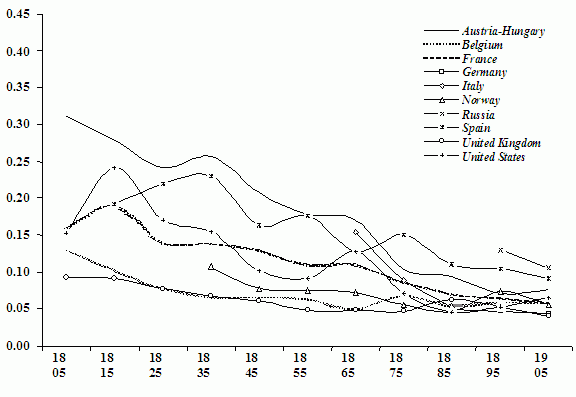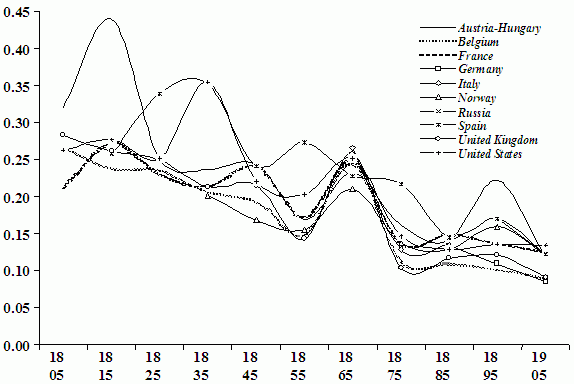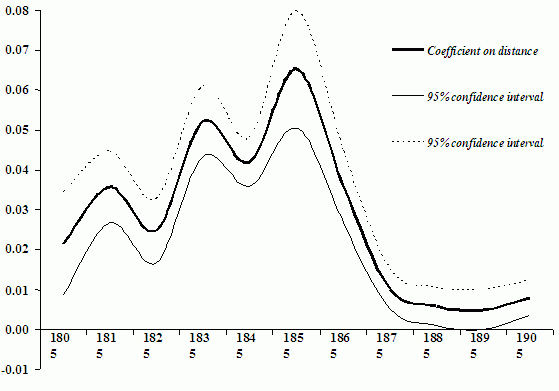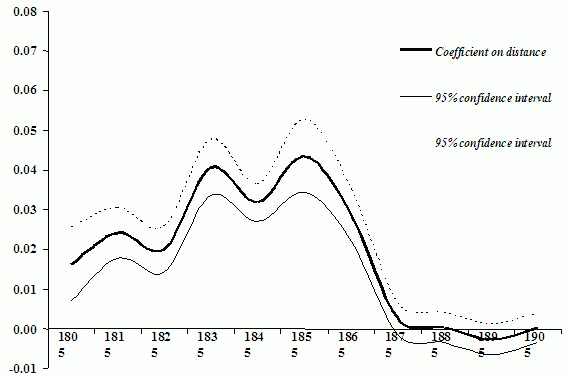Since Cairncross (1997), the notion of the “death of distance” has gained traction, both in the work of academics but more especially in the popular image of globalisation. Citing radical improvements in the cost and efficacy of long-distance communication and transportation, Cairncross depicts a world marked by the free movement of goods, people, and ideas. Unfortunately, this prognosis has been difficult to identify in present-day trade data. One of the first studies to recognise this was Leamer and Levinsohn (1995), who write “that the effect of distance on trade patterns is not diminishing over time. Contrary to popular impression, the world is not getting dramatically smaller”.
Taking this view as a starting point, a string of papers has strongly confirmed their initial results. Berthelon and Freund (2008) find corroborating evidence in highly disaggregated trade data. Their main findings are that changes in the composition of trade cannot account for the time-invariant coefficients on distance emerging from gravity equations and that trade in homogeneous products has tended to become more sensitive to distance.
Adding support to this view, Carrère and Schiff (2005) argue that the importance of distance in trade has been on the march in recent times. They make this claim on the basis of a trade-weighted measure of the distance separating trade partners (or distance-of-trade) which has been falling from the 1960s. Additionally, this declining distance-of-trade is observed in the majority of nations, suggesting that the result is not driven by distinctions in the trading relations of rich versus poor countries.
Finally, Disdier and Head (2008) collect over 1000 distance coefficients estimated from gravity equations in 78 previous studies and perform a meta-analysis. They find that the estimated distance coefficient has been on the rise from 1950, suggesting that the “death of distance” has been greatly exaggerated.
New evidence from old data
In recent research (Jacks, 2009), I use data drawn from the nineteenth century to examine this paradox. Rather than relying on information on bilateral trade flows, I choose to exploit the abundant price evidence from international commodity markets, for a number of reasons. First, the “death of distance” is implicitly a statement about the diminished importance of distance in determining the actual costs of engaging in international trade. That is, with improvements in technology, distance-related components of trade costs – things like freight rates, insurance premiums, and inventory costs – should fall. Second, the nineteenth century was a time of unsurpassed declines in international trade costs (Jacks, Meisnner, and Novy, 2009). The implication is that if distance died at any time in history, we should be looking to the nineteenth century for clues.
Trends in intra- and international trade costs
The dependent variable used is the standard deviation of the logged relative price of wheat in two cities over ten year periods. The reason for the choice of this variable is relatively straightforward; it is widely used in the contemporary literature (Engel and Rogers, 1996), so the comparability of results looms large. Additionally, Anderson and van Wincoop (2004) have argued that this measure does a reasonably good job of capturing the level of trade costs in simulations.
From the perspective of the present day, the choice of focusing on any one commodity – let alone wheat – may seem an odd one. After all, in 2000, the global wheat trade accounted for roughly 0.2% of the $6.4 trillion in global exports. However, the situation was much different in the nineteenth century, as trade in commodities predominated. Even as late as the 1890s, grains constituted fully 14% of the UK’s imports and a similar share of US exports. Thus, wheat markets seem to be a suitable benchmark by which to gauge the effects of distance during the first wave of globalisation.
Figures 1 and 2 depict the evolution of this measure through time, clearly confirming that the nineteenth century was a time of radical declines in both intra- and international trade costs.
Figure 1 Trade costs (intranational city pairs)
Figure 2 Trade costs (international city pairs)
Statistical tests on the death of distance
The next step is to relate the dependent variable with standard controls from the contemporary literature; for instance, nominal exchange rate volatility and an indicator variable for the existence of a border between two cities. The key independent variable for present purposes is the distance separating two cities. Distance is calculated intranationally as the linear distance between two cities and calculated internationally as the sum of the linear distance to the nearest port and the trade-route specific (nonlinear) distance between departure and arrival ports. Thus, distance is fully separable into intra- and international components. As a first pass, I find that the dependent variable – a proxy for trade costs – is indeed increasing in distance, nominal exchange rate volatility, and the presence of national borders.
I also consider distance effects over time. The estimated effect for the sum of intra- and international distances in the period 1900-1910 is found to be 83% less than that of 1800-1810. What is more, most of the gains in this regard seem to be concentrated later in the period with 1870 clearly marking the transition.
A further exercise is also explored, namely the differential effects of overland and maritime distances. The estimated coefficients on intranational and international distances are depicted in Figures 3 and 4, respectively. The results in this instance are telling. After climbing throughout the first half of the nineteenth century, the coefficients on intranational distances fall in the period after 1860, reaching a level in 1900-1910 which is roughly 63% of the 1800-1810 value. The coefficients on international distance remain somewhat (but not radically) smaller than those on intranational distances and trace essentially the same course from 1800 to 1870. The period after 1870, however, witnesses their absolute collapse. Indeed, the coefficients become very small in magnitude and statistically indistinguishable from zero.
Figure 3 Distance effects over time (intranational distances)
Figure 4 Distance effects over time (international distances)
Running parallel to these results, Flandreau (1995) finds a sharp decline in distance coefficients in a standard gravity model of European trade flows in the period between 1870 and 1880. Thus, the coincidence of declining (absolute) values for the distance coefficients on both trade costs and trade flows in this period allows for a plausible story in which the amelioration of nominal exchange rate volatility, adoption of the gold standard, the global spread of communication networks via the telegraph, and the maritime transport revolution lowered trade costs and, thus, stimulated trade flows.
Implications for the contemporary debate
By investigating time-dependent effects of distance on trade costs over the long run, I have been able to document clear declines in the importance of distance in the late nineteenth century. This finding runs counter to the work for the post-1950 era where researchers have identified a surprising persistence of distance’s effect on bilateral trade. This suggests that international trade costs may have not declined nearly as dramatically in the late twentieth century as has been supposed, especially in light of the nineteenth century experience, a time of well-documented and large trade cost declines. For better or worse, distance is still alive and kicking.
References
Anderson, J.E. and E. van Wincoop (2004), “Trade Costs.” Journal of Economic Literature 42, 691-751.
Berthelon, M. and C. Freund (2008), “On the Conservation of Distance in International Trade.” Journal of International Economics 75(2), 310-310.
Cairncross, F. (1997), The Death of Distance. Cambridge: Harvard Business School Press.
Carrère, C. and M. Schiff (2005), “On the Geography of Trade: Distance is Alive and Well.” Revue Economique 56(6), 1249-1274.
Disdier, A. and K. Head (2008), “The Puzzling Persistence of the Distance Effect on Bilateral Trade” Review of Economics and Statistics 90(1), 37–48.
Engel, C. and J.H. Rogers (1996), “How Wide is the Border?” American Economic Review 86(5), 1112-1125.
Flandreau, M. (1995), “Trade, Finance, and Currency Blocs in Nineteenth Century Europe: Was the Latin Monetary Union a Franc-Zone? 1860-1880.” In J. Reis (Ed.), Historical Perspective on International Monetary Arrangements. New York: Macmillan.
Jacks, D.S. (2009), “On the Death of Distance and Borders: Evidence from the Nineteenth Century.” National Bureau of Economics Research Working Paper 15250.
Jacks, D.S., C.M. Meissner, and D. Novy (2009), “Trade Booms, Trade Busts, and Trade Costs.” National Bureau of Economic Research Working Paper 15267.
Leamer, E.E. and J. Levinsohn (1995), “International Trade Theory: The Evidence.” In G.M. Grossman and K. Rogoff (Ed.s), Handbook of International Economics, vol. III. New York: Elsevier.





